Following the Great Deportation during the
summer of 1942, a profound change took
place in the Jewish outlook. The awful truth of what had taken place, became
too apparent. Those who had been deported were dead, and those that remained faced
the same end. The longing for relatives who had been torn away and the searing
pain over their loss were truly felt only after the deportations had ended, mixed
with feelings of guilt for remaining alive. A new mood arose in this post
deportation period, deep hatred for the Nazis, desire for revenge, and the
growth of determined resistance.
At the
end of October 1942, a consultation was held at the
Ha-Shomer Hazair
headquarters
at
61 Mila Street, and the ZOB had been consolidated and enlarged with
the addition of youth movements and splinter groups of underground political parties of all
persuasions from Zionists to Communists. A ZOB command was formed, made up of
representatives of the founding organisations and the combat groups. At this
October 1942 meeting on the agenda were two key subjects: the defence of the Warsaw
ghetto, and to teach the Jewish Police and workshop owners a lesson.
The ZOB's first operations were directed against the Jewish Police, in retaliation
for its diligence and brutality during the mass deportations, senior officials
of the
Judenrat who were known to be on close terms with the Germans, and Jews
who had developed a reputation as agents for the various branches of the
German police. The ZOB leadership were convinced that the ghetto could not be
set in gear for an armed struggle, as long as it contained a Fifth Column,
prepared to collaborate with the Germans, by passing on information, or handing
Jews over to the Germans.
Following the unsuccessful assassination attempt on
Jozef Szerynski on
20 August 1942 by
Yisrael Kanal, the first
person condemned to death by the ZOB was
Jacob Lejkin, who
as
Szerynskiís deputy, had played a leading role in the
mass deportations. The assassination was planned with great care, and the group
that accepted the mission consisted of three members of the
Ha-Shomer Hazair:
Margalit Landau and
Mordechai Grobas
trailed
Lejkin for some time, charting his regular movements
and hours of work, while
Eliyahu Rozanski was chosen as the assassin.
Towards evening on
29 October 1942 Lejkin was
shot to death while walking from
the police station to his home on
Gesia Street. His aide,
Czaplinski, who was walking by his side, was injured.
The next assassination was directed against
Yisrael First, a senior official
of the
Judenrat. First had been one of the directors of the Economic Department,
but his influence extended far beyond that sphere. From the earliest of the
Judenrat, he had been the councilís liaison officer with various branches of
the German police, and he played a part during the "Great Action". The assassination
was carried out on
28 November 1942, by
David Schlman
of
Dror He Halutz, on
Muranowska Street.
The second wave of deportations was launched on
18 January 1943. This time,
however, the Jews who were ordered to assemble in the courtyards of their
apartment houses to have their papers examined, refused to comply and went
into hiding. The first column that the Germans managed to up in the first few
hours, consisted of some one thousand persons, who offered a different kind of resistance.
A group of fighters, led by
Mordechai Anielewicz, armed with pistols,
deliberately infiltrated the column that was on its way to the
Umschlagplatz.
When the agreed upon signal was given, the fighters stepped out of the column
and engaged the German escorts in hand-to-hand fighting. The column dispersed,
and news of the fight, which had taken place in the street of the central ghetto,
soon became common knowledge.
Eliyahu Rozanski and
Margalit Landau
who were involved in the killing of Lejkin, fell in this battle,
Anielewicz
was nearly killed after running out of ammunition.
That first day the Germans also met with armed resistance on the corner
of
Zamenhofa and
Mila Streets, from an
apartment in which a group of Dror members including
Yitzhak Zuckerman, had
taken up positions. Some SS-men were killed, others ran off, leaving their weapons behind.
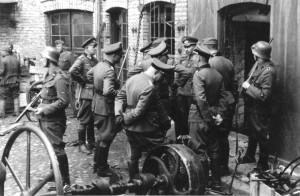 |
| Clearing of a Factory* |
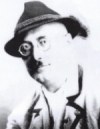 |
| v. Sammern |
According to German sources on
20 January 1943 two SS-battalions surrounded
Többens and
Schultzís shops. This operation was commanded by
von
Sammern-Frankenegg and the commandant of
Treblinka I labour camp,
Theodor von Eupen. The fact
that the "action" was halted after a few days, and that the Germans have managed to seize no more than 10% of the
ghetto population, was regarded by Jews and Poles alike as a German defeat.
The Germans however, had not intended to deport the whole ghetto. In fact they carried out an order by
Heinrich Himmler (after his visit to Warsaw on
9 January 1943), to deport 8,000 Jews from the ghetto. With this deportation the
levels set by
Himmler prior to the "Great Action", would be met.
The deportations and other events that took place in
January were to have
a decisive influence on the last months of the ghetto existence, up to
April
and May 1943. The
Judenrat and the Jewish police lost whatever control they
still had over the ghetto. In the central part of the ghetto it was the
fighting organisations that were obeyed by the population.
Odilo Globocnik appointed
one of the German shop owners,
Többens, as Ghetto commissar. His assignment
was to transfer the machinery and workers of the major shops in the Warsaw
Ghetto to labour camps in the
Lublin area.
Többens however, ran into opposition from the workers, who were taking
their instructions from the ZOB.
The Jewish resistance also impressed the Poles, and they now provided
more aid to the Jewish fighters than in the past. The fighting organisations
used the few months they had left before the final liquidation to consolidate,
equip themselves, and prepare a plan for the defence of the ghetto.
The ZOB now had 22 fighting squads, of 15 fighters each, the Military
Union had about half the number of fighters, but it operated in a similar manner.
The ghetto as a whole was engaged in feverish preparations for the expected
deportation, which all believed would be the last and the final one. The
general population concentrated on preparing bunkers. Groups of Jews, made up
mostly of tenants of the same building, went to work on the construction of
subterranean bunkers, shelters such as these had helped evade capture during the
January 1943 deportations. Many Jews were now ready to entertain the hope that
the combination of resistance and hiding might provide the route to rescue.
 |
| Bunker #1* |
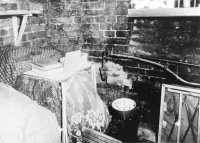 |
| Bunker #2* |
The network of bunkers in the ghetto was expanded, and a substantial part
of the ghetto population was kept busy at night digging the hideouts and
communication trenches under the ground. Much thought and sophistication went
into the planning of the entrances and exits of the hiding places. Bunkers and
wooden bunks were installed in them, and air circulation was provided for,
as well as electricity and water supplies, food, and medicines to last for months.
The preparation of bunkers became a mass movement in the central ghetto area,
and as the final deportation drew near every inhabitant of the ghetto had two
addresses - one on the ghetto surface and a subterranean one in a bunker.
Revolt and Final Liquidation
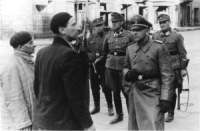 |
| SS questioning Ghetto Fighters* |
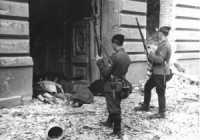 |
| Trawnikis after shooting Tenants* |
The final liquidation of the ghetto began on
19 April 1943, the eve of
Passover. This time the deportation did not come as a surprise. The Jews had
been warned of what lay ahead and they were ready. The Germans had a substantial
military force on the alert for the deportation, but they were taken by surprise,
by the street battles, and the determination of the Jews to resist. This lack of
understanding cost
SS-Oberführer Ferdinand von
Sammern-Frankenegg his post as
HSSPF Warschau.
Himmler
replaced him with
SS- and Police General
Jürgen Stroop, who was experienced in fighting partisans,
to supervise the deportation and liquidation of the ghetto. In his
telex to the
HSSPF Ost,
F.W. Krüger, from
22 April 1943
Himmler ordered the most possible toughness for the ghetto liquidation.
Stroopís daily progress reports
to
Krüger and his final summary
when the revolt had come to an end, constitute the basic historical documentation
of the resistance offered by the Jews and the methods used by the Nazis to overcome it.
According to
Stroop the
Großaktion ("Great Action")
began on
19 April 1943, when a strong police force surrounded the ghetto at 3 a.m..
The German armed forces that had been assembled for the operation consisted of 850 men
and 18 officers, under the command of
von Sammern-Frankenegg.
It entered the ghetto in two sections, met with armed resistance
and was forced to retreat. The forces were drawn from
SS Panzergrenadiere,
cavalry training, SS and police regiments, technical emergency corps, security police,
Wehrmacht engineers,
Trawniki-Männer from the SS training camp
Trawniki, as well as Polish police and fire brigade personnel.
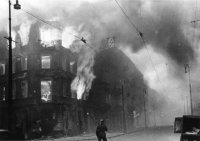 |
| The Ghetto in Flames* |
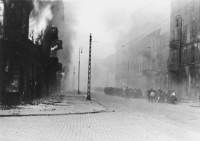 |
| Marching to the Umschlagplatz* |
On the first day the Germans became aware of the kind of uprising
they were facing. The central ghetto, which had a population of more than 30,000,
was completely empty, except for a handful of
Judenrat members and a Jewish
police unit. No Jews could be rounded up for deportation, and the freight cars at
the
Umschlagplatz had to remain empty. The magnitude of the hiding operation took
the Germans by surprise, as had the armed resistance.
In the first three days, street battles took place in the ghetto,
Stroop decided
to systematically set fire to the buildings to flush out the fighters. This meant that
the Jewish fighters had to abandon their positions and seek refuge in the bunkers.
The ghetto was now one great burning torch, enveloped in dense smoke and
permeated by stifling odours. The temperatures in bunkers below burning houses
reached boiling point. Most of the food was spoiled by the devastating heat,
the people had to quench their thurst by drinking warm and stinking water.
One could hardly breathe or talk, being on the verge of going mad, but still the Jews
refused to surrender to the Germans.
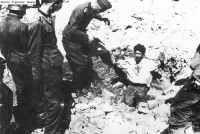 |
| Emerging a Bunker #1* |
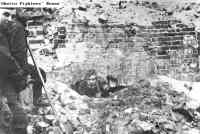 |
| Emerging a Bunker #2* |
Under cover of darkness they tried to leave the burning bunkers. Everyone looked for a
bunker where conditions could be slightly better, although this was
likely to be a temporary improvement. In the second week of the uprising, the bunkers
were the main arena of resistance. In this fight, the Germans had to struggle for each
bunker. They used tear gas or poison gas, forcing the Jews out. In many
instances Jews kept firing as they emerged, and a number of women fighters threw
grenades, hidden in their clothes, after they had surrendered. The Germans made the
Jewish women remove their clothes, in order to lessen the chances of being killed
or wounded.
On
8 May 1943, the command bunker of the ZOB, which contained about 100 people,
was attacked by the Germans. The five exits were blocked, the main entrance was
broken open and canisters of poisonous gas were thrown inside.
Arie Wilner and
Lolek Rotblat called on the fighters to take their own
lives rather than surrender to the Germans. Some of the fighters did indeed commit suicide,
while others were killed by the gas, some managed to escape.
Mordechai Anielewicz, the leader of the
revolt, fell at
18 Mila Street, along with many other brave fighters.
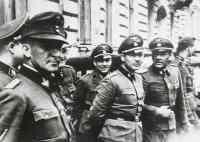 |
| Stroop |
On
16 May 1943,
Stroop announced that
the
Großaktion had been completed. To mark the end of this action, he ordered the destruction of the
Great Warsaw Synagogue on
Tlomackie Street, at 8 p.m..
In his
final report on the military campaign that he led against
the ghetto revolt,
Stroop provided the following data: Of the total
of 56,065 Jews who were seized, 22,000 were deportated to
Majdanek, 14,000 - 16,000 to
Poniatowa, 5,000 - 6,000 to
Trawniki, and 7,000 to
Treblinka.
5,000-6,000 lost their lives in explosions and fires.
Stroop exaggerated the
figures of Jews exterminated, as well as reducing the casualty figures experienced by his forces, 16 killed and
85 wounded.
Stroop proposed establishing a concentration camp in Warsaw.
Its prisoners could be used to clear away the ruins and buildings on the territory of the former ghetto.
Between 16 May and 19 July 1943 Stroop's idea
was realized and
KZ Warschau established.
In
1951,
Stroop was tried in Warsaw. He was
sentenced to death for war crimes, and hanged.
Stroopís report was used at the
Nürnberg War Crimes Trial in Germany.
Photos:
USHMM
*
GFH
*
Sources:
Encyclopaedia of the Holocaust
Yisrael Gutman. The Jews of Warsaw 1939-43. Harvester Press, 1982
The Stroop Report
© ARC (http://www.deathcamps.org) 2005



















